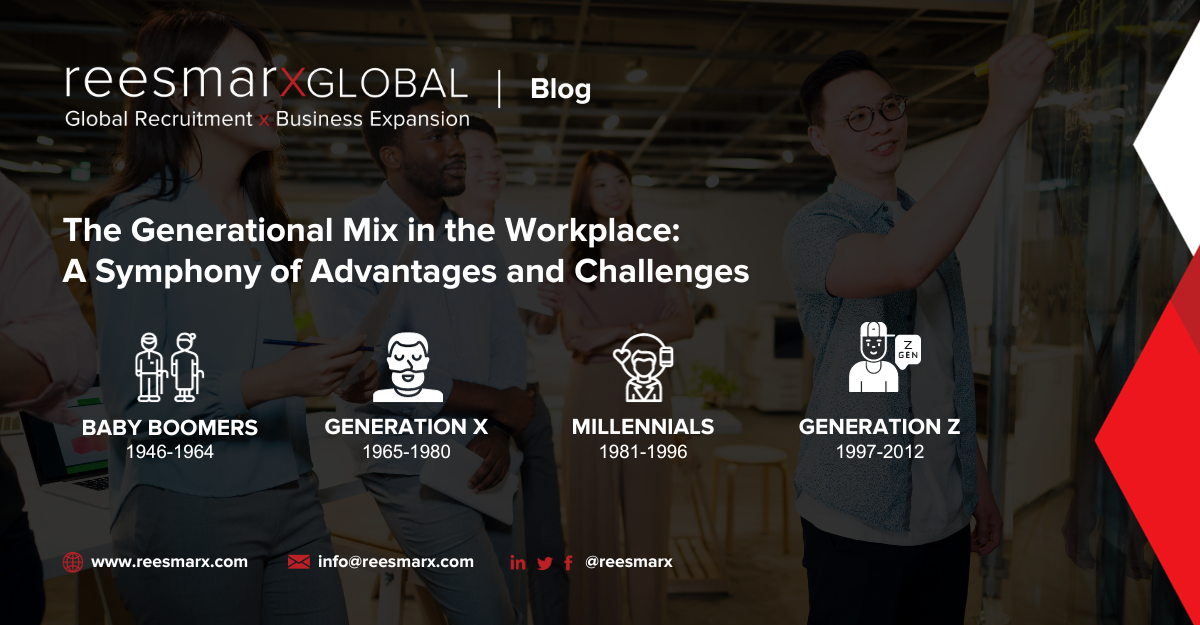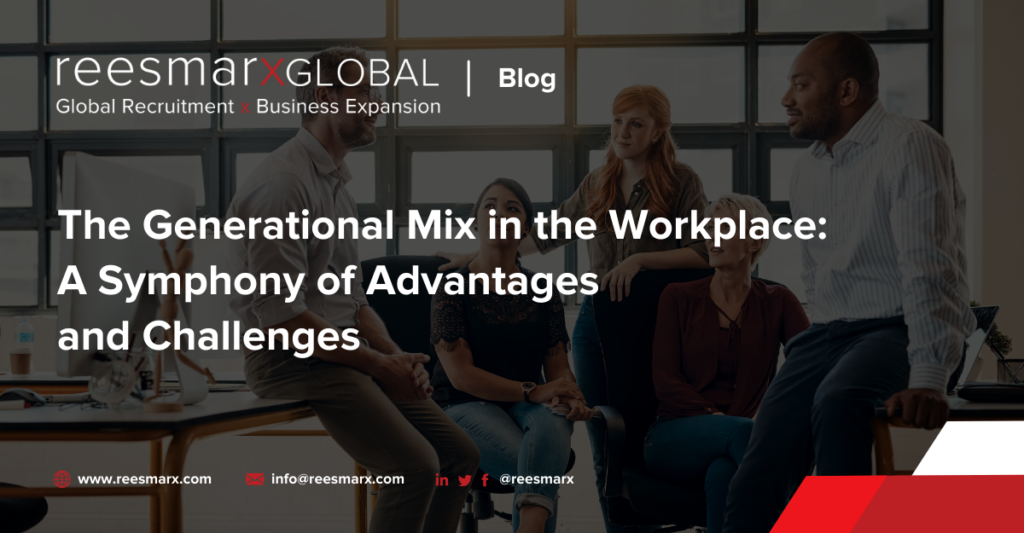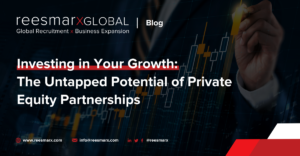In the fast-paced world of modern business, the workplace is a fascinating mosaic of generations, each contributing a unique blend of experience, skills, and perspectives. From Baby Boomers who built industries to Gen Z, the tech-savvy newcomers, every generation adds a distinct note to the symphony of the workplace. In this blog post, we’ll delve into how each generation influences the workplace, their relationship with technology, the impact of remote and hybrid work, and the very real and disturbing issue of ageism. Additionally, we’ll share revealing case studies and regional insights to provide a more human perspective on this captivating phenomenon.
The Rhythm of Each Generation
The Rhythm of Each Generation.
Let us remind you of each generation and how they are distinguished.
Baby Boomers (1946-1964): These seasoned professionals bring a wealth of experience and a strong work ethic. Often found in leadership roles, they are the architects of many industries.
Generation X (1965-1980): Gen Xers, known for their adaptability and self-reliance, serve as the bridge between traditional and modern workstyles.
Millennials (1981-1996): With their digital native status, Millennials have reshaped the workplace, emphasizing technology, collaboration, and work-life balance.
Generation Z (1997-2012): The newest entrants to the workforce, Gen Z, infuse it with their tech prowess, creativity, and entrepreneurial spirit.

The Harmony of Technology.
Technology has become the lifeblood of the modern workplace, but its embrace differs across multiple generations.
The Orchestra of Advantages: Millennials and Gen Z members lead the way in technology adoption, infusing the workplace with fresh ideas and digital skills. They are the driving force behind innovation and the champions of flexible work arrangements. They can be likened to the virtuoso performers in this technological orchestra. They embrace technology effortlessly and leverage it to drive innovation and promote flexible work arrangements. Here are some illustrations:
The Harmony of Technology.
Technology has become the lifeblood of the modern workplace, but its embrace differs across multiple generations.
The Orchestra of Advantages: Millennials and Gen Z members lead the way in technology adoption, infusing the workplace with fresh ideas and digital skills. They are the driving force behind innovation and the champions of flexible work arrangements. They can be likened to the virtuoso performers in this technological orchestra. They embrace technology effortlessly and leverage it to drive innovation and promote flexible work arrangements. Here are some illustrations:
Illustration 1: Innovation in Practice
Imagine a marketing team where a Millennial manager introduces a cutting-edge AI-powered customer analysis tool. This technology enables the team to predict customer behavior more accurately, resulting in more effective marketing campaigns and increased revenue. The younger generation’s familiarity with such tools and willingness to explore new tech solutions catalyzes positive organizational change.
Illustration 2: Flexible Workstyles
In a global tech startup, Gen Z employees lead the way in advocating for flexible work arrangements. They introduce collaborative tools like Slack and Trello, allowing team members to work from different time zones while maintaining efficient communication. As a result, the company attracts top talent worldwide and thrives in a virtual workspace.
Discordant Notes: Some Baby Boomers and Gen Xers may struggle to keep pace with the rapid evolution of technology. Many Baby Boomers and Gen Xers may find themselves navigating through the technological score with a degree of hesitation. The rapid evolution of technology can create dissonance, leading to feelings of obsolescence and prompting the need for continuous upskilling.

Illustration 3: Bridging the Gap
Consider a traditional manufacturing company where a Baby Boomer supervisor oversees a machinery-operating team. As automation and digitalization become industry norms, the supervisor initially feels overwhelmed by the new technology. However, the company recognizes the value of their experience and invests in training programs. With time and support, the Baby Boomer adapts to the technology and becomes a mentor to younger team members, blending experience with modern tools to optimize production.
Illustration 4: The Upskilling Journey
In a corporate setting, a Gen X project manager realizes the importance of adapting to emerging technology trends to stay relevant in the industry. They proactively attend workshops, gain certifications, and collaborate with younger colleagues. Over time, their newfound digital prowess boosts their career and inspires other Gen X team members to embark on similar upskilling journeys.
Remote and Hybrid Working
The global COVID-19 pandemic propelled remote and hybrid work into the spotlight, impacting generations differently.
The Uplifting Tune: Gen X and Millennials have generally embraced remote work, cherishing the flexibility it offers. This newfound flexibility has allowed them to harmonize work and personal life more effectively.
The Challenges in the Score: Baby Boomers and some Gen Xers find remote work isolating and grapple with the absence of in-person interaction. This can have repercussions on their mental well-being and productivity.
The Ageism Overture
Ageism, the discrimination or prejudice against individuals based on age, is prevalent in many workplaces. It often affects older generations, who may be unfairly judged due to perceived technological limitations, creating a dissonance in the workplace orchestra.
Real-Life Examples of Ageism:
Tech Industry Bias: Older employees sometimes face ageism in the fast-paced tech industry. They may not be considered for roles or promotions involving cutting-edge technologies, even if they offer valuable experience and insights.
Illustration: Imagine a tech startup in Silicon Valley that hesitates to hire a seasoned software engineer in their late 50s for a lead developer role because they assume they won’t adapt to the latest coding languages. This bias can deprive the company of valuable experience and mentorship.
Youth-Centric Marketing Agencies: In marketing and advertising agencies targeting youth markets, there’s often a preference for younger employees who are seen as more in touch with current trends. Older marketing professionals may find themselves sidelined.
Illustration: Picture a trendy marketing agency specializing in Gen Z advertising campaigns. The management team, predominantly composed of Millennials, may inadvertently overlook the insights and strategic acumen that a Baby Boomer marketer with decades of experience can bring.
Tech Startups and Age Bias: While known for their innovative ideas, some tech startups may inadvertently perpetuate ageism. They might create a culture that idealizes youthful energy and overlooks the potential contributions of older employees.
Illustration: Consider a fledgling tech startup focused on app development. Their hiring preference leans heavily toward fresh college graduates, believing they are more attuned to mobile trends. This approach can disregard the wealth of experience a Gen X product manager could provide regarding product strategy and customer insights.
Age-Blind Hiring Practices: In some industries, the push for age-blind hiring practices can inadvertently lead to older candidates being excluded. Companies may overemphasize tech-savvy skills during recruitment, disregarding other valuable qualities older workers bring to the table.
Illustration: Think of a financial institution that aims to modernize its operations by adopting cutting-edge fintech solutions. To attract young talent, they might overlook a Baby Boomer financial analyst’s deep financial expertise.
Promotion Delays: Ageism can manifest as delayed promotions for older employees, even when they excel. The assumption that they lack the agility or willingness to adapt to new responsibilities can hinder their career progression.
Illustration: Imagine a corporate environment where a Gen X middle manager consistently delivers outstanding results. Despite their qualifications, they are passed over for promotion in favor of younger colleagues.

IBM’s Returnship Program: A Real-Life Overture Against Ageism
IBM’s proactive approach to addressing ageism is both inspiring and impactful. They’ve launched initiatives such as “Returnship” to combat ageism head-on. The Returnship program aims to re-engage retired employees, tapping into their wealth of experience while simultaneously bridging the digital skills gap.
Illustration of IBM’s Returnship Program: Consider a scenario where a Baby Boomer software engineer who retired a few years ago is invited to join IBM’s Returnship program. This engineer brings decades of experience in software development but lacks familiarity with newer programming languages. IBM provides targeted training and mentorship, enabling them to adapt to the latest technologies quickly. As a result, the engineer rejuvenates their career and becomes a valuable resource for younger colleagues, fostering cross-generational knowledge sharing.
By recognizing and actively addressing ageism, organizations like IBM are taking a crucial step towards creating inclusive and diverse workplaces where every generation can contribute unique strengths and experiences. Such initiatives benefit older workers, enrich the overall work environment, and contribute to a more harmonious workplace symphony.
Regional Melodies
Let’s explore the regional compositions of the workforce, where age distribution plays a unique tune:
North America: Gen X and Millennials dominate the workforce, with Baby Boomers still holding key leadership positions.
Western/Southern EU: Like North America, Gen X and Millennials form the backbone, with a growing Gen Z presence in tech-focused sectors.
APAC: This region boasts a younger workforce, with Millennials and Gen Z making up a substantial portion. Traditional values and technologies can still be influential in some industries.
Africa: The workplace is a mosaic of generations, with Gen Z’s zeal for entrepreneurship and tech innovation making a significant impact.
Central/Eastern EU: Gen X plays a crucial role in bridging generational gaps, fostering collaboration between Baby Boomers and Millennials. The region is experiencing a tech-driven transformation.
South America: Similar to Africa, South America enjoys a diverse workforce, with Gen Z driving tech innovation and Millennials shaping the future of work.
The symphony of generations in the workplace is a rich composition of strengths, diversity, and challenges. Embracing this diversity, promoting intergenerational collaboration, and addressing ageism is essential for creating a harmonious and innovative work environment. The key lies in recognizing and celebrating the unique contributions of each generation, harmonizing them to create a melodious workplace symphony in the ever-evolving global business landscape.
Contact reesmarxGLOBAL Today
reesmarxGLOBAL is your dedicated partner in navigating the intricate terrain of global talent acquisition. Our legacy of excellence in recruitment and executive search empowers businesses to secure top-tier talent, even in the face of economic challenges.
We invite you to reach out to us today and embark on a journey to redefine your recruitment strategies in an ever-evolving world. Our seasoned experts are poised to assist you in overcoming the hurdles posed by economic uncertainties. Let’s embark on this journey together towards a future of talent abundance and business success. Contact us now.






